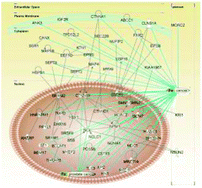Large scale phosphoproteome analysis of LNCaP human prostate cancer cells†
Abstract
Prostate cancer is the most frequently diagnosed cancer among men in the western world. The androgen receptor, a phosphoprotein, is suspected to be involved in all stages of the prostate cancer. Androgen receptor activity can be modulated by various kinases such as PKA, MAPK, AKT, and Src. Phosphorylation is an important post-translational modification and serves as a molecular on–off switch to regulate signaling. Disruptions of cellular phosphorylation are associated with various diseases such as cancer and kinases provide important drug targets. Here we present an analysis of the phosphoproteome in LNCaP human prostate cancer cells. The analytical strategy employed here used proteomics based methodologies with a combination of detergents and chaotropic reagents during trypsin digestion followed by titanium dioxide enrichment of phosphopeptides. Over the course of multiple analyses by mass spectrometry we identified a total of 746 phosphorylation sites in 540 phosphopeptides corresponding to 116 phosphoproteins, of which 56 had not been previously reported. Phosphoproteins identified included transcription factors, co-regulators of the androgen receptor, and cancer-related proteins that include β-catenin, USP10, and histone deacetylase-2. The information of signaling pathways, motifs of phosphorylated peptides, biological processes, molecular functions, cellular components, and protein interactions from the identified phosphoproteins established a map of phosphoproteome and signaling pathways in LNCaP cells.


 Please wait while we load your content...
Please wait while we load your content...